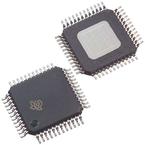The TUSB4020BI is a two-port USB 2.0 hub. It provides USB high-speed/full-speed connections on the upstream port and provides high-speed, full-speed, or low-speed connections on the two downstream ports. When the upstream port is connected to an electrical environment that supports high-speed and full-speed/low-speed connections, high-speed and full-speed/low-speed USB connectivity is enabled on the downstream ports. When the upstream port is connected to an electrical environment that only supports full-speed/low-speed connections, high-speed connectivity are disabled on the downstream ports.
●The TUSB4020BI supports per port or ganged power switching and overcurrent protection.
●An individually port power controlled hub switches power on or off to each downstream port as requested by the USB host. Also when an individually port power controlled hub senses an over-current event, only power to the affected downstream port will be switched off.
●A ganged hub switches on power to all its downstream ports when power is required to be on for any port. The power to the downstream ports is not switched off unless all ports are in a state that allows power to be removed. Also when a ganged hub senses an overcurrent event, power to all downstream ports will be switched off.
●The TUSB4020BI downstream ports provide support for battery charging applications by providing battery charging connected downstream port (CDP) handshaking support. It also supports a dedicated charging port (DCP) mode when the upstream port is not connected. The DCP mode supports USB devices which support the USB Battery Charging and the Chinese Telecommunications Industry Standard YD/T 1591-2009. In addition, an automatic mode provides transparent support for BC devices and devices supporting Divider Mode charging solutions when the upstream port is unconnected.
●The TUSB4020BI provides terminal strap configuration for some features including battery charging support, and also provides customization though OTP ROM, I2C EEPROM or through an I2C/SMBus slave interface for PID, VID, and custom port and phy configurations. Custom string support is also available when using an I2C EEPROM or the I2C/SMBus slave interface.
●The device is available in a 48-pin HTQFP package and is offered in an industrial version for operation over the temperature range of –40°C to 85°C.


